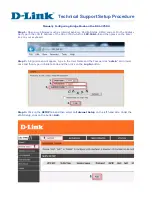
Software User Manual
D-Link Unified Access System
02/15/2011
Document 34CS3000-SWUM104-D10
Page 77
Section 6: Configuring Access Point Settings
After you validate a D-Link Access Point that associates with a switch, the switch assumes management functions for the
AP. You can configure all of the AP settings directly from the switch before or after you validate the AP. The D-Link Unified
Access System utilizes the D-Link Wireless AP Protocol (DWAPP) for the switch to discover, configure, manage, and monitor
the APs. This chapter describes the AP settings and how to manage them by using the D-Link Unified Switch.
This chapter contains the following sections:
•
“AP Profiles, Networks, and the Local Database”
•
“Configuring AAA and RADIUS Settings”
•
“Configuring Wireless Radio Settings”
•
“Configuring SSID Settings”
•
“Configuring Valid Access Point Settings”
For information about the commands you use to configure access point settings by using the CLI, refer to the
D-Link CLI
Command Reference
.
AP Profiles, Networks, and the Local Database
This section provides an overview of the access point profiles, wireless networks, and the local access point database that
you configure on the D-Link Unified Switch.
Access Point Profiles
You manage the configuration of D-Link Access Points through the use of configuration profiles. A profile is like a
configuration template that you can apply to one or more APs. The D-Link Unified Switch allows you to create multiple
configuration profiles for access points. When you validate an AP, you can specify which profile the AP receives.
You can define many AP profiles on the Unified Switch, but each access point can only have one profile at a time. You can
use the same profile for multiple APs, or you can create a unique profile to assign each AP that the switch manages. An
existing profile and all of its configurations may be copied to another profile or used to create a new profile. Each
configuration profile can have unique settings for the following access point features:
•
RADIUS server settings
•
MAC authentication list
•
Radio interface and RF configuration
•
QOS Configuration
•
Virtual Access Point (VAP) Configuration
When you modify and apply a profile, the switch applies the changes to the APs it manages that use the modified profile.
Note:
Changing some access point settings might cause the AP to stop and restart system processes. If this
happens, wireless clients will temporarily lose connectivity. We recommend that you change access point settings
when WLAN traffic is low.
















































